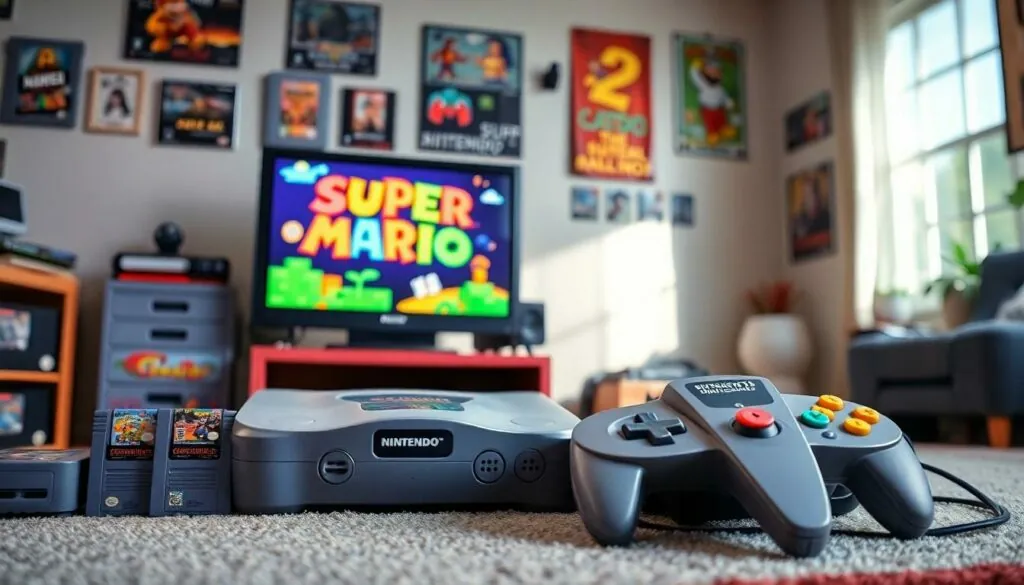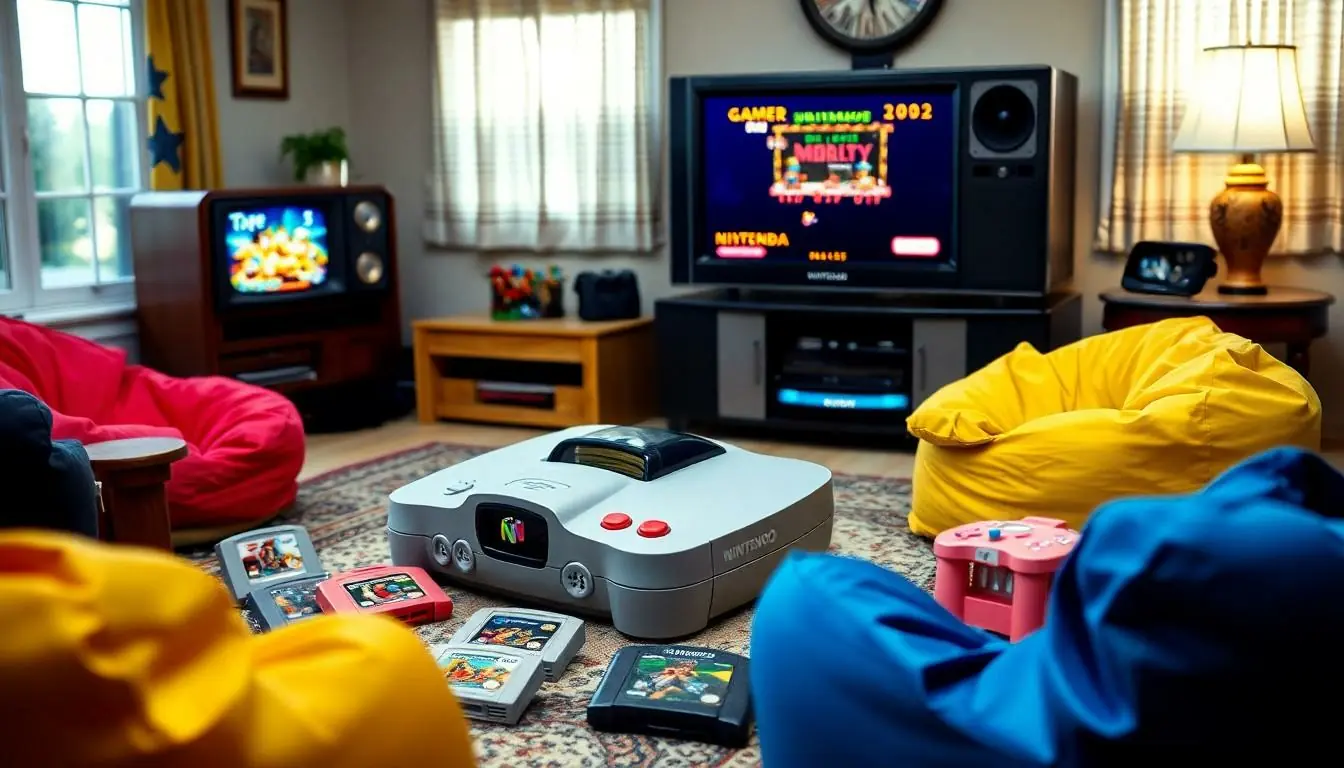The Nintendo 64, a beloved gem in the gaming world, took the industry by storm when it hit the shelves in the mid-’90s. With its vibrant graphics and groundbreaking 3D gameplay, it quickly became a favorite among gamers seeking adventure and nostalgia. But what about that original price tag? Spoiler alert: it wasn’t exactly pocket change for a kid with a paper route!
Back in 1996, the Nintendo 64 launched at a price that made parents clutch their wallets tighter than Mario clutches a power-up. For those who remember, it was a hefty $199.99—an investment that promised hours of fun and a few friendly arguments over who got to be player one. Join us as we dive into the fascinating world of gaming history and explore how that original price shaped the legacy of this iconic console.
Table of Contents
ToggleOverview of Nintendo 64
Nintendo 64, released in June 1996, marked a significant development in gaming technology. This console featured a unique cartridge system that allowed for impressive graphics and innovative gameplay. Developers created iconic titles, establishing franchises that remain relevant today.
At launch, the Nintendo 64’s price of $199.99 positioned it as a premium gaming experience. Families viewed this investment as substantial, particularly during a time of economic variability. Competing consoles, such as Sony’s PlayStation, utilized disc-based formats, but Nintendo’s choice of cartridges provided faster loading times and enhanced graphics quality.
The console’s roster of games included classics like “Super Mario 64,” “The Legend of Zelda: Ocarina of Time,” and “GoldenEye 007.” These titles showcased the capabilities of the Nintendo 64, appealing to both casual gamers and enthusiasts. Multiplayer functionality gained acclaim, as families and friends enjoyed games together.
Despite its initial success, the Nintendo 64 faced challenges in the market. Competing platforms often offered a broader selection of third-party titles, while Nintendo’s focus relied heavily on its established franchises. Nevertheless, the console secured a loyal fanbase that cherished its unique gaming experiences.
Overall, the Nintendo 64’s legacy continues to influence video game design and development. Its innovative approach to graphics, gameplay, and multiplayer features laid the groundwork for future consoles, ensuring its place in gaming history.
Historical Context of video game pricing
Video game pricing shifted significantly in the 1990s, reflecting both technological advancements and consumer expectations. The Nintendo 64 debuted at $199.99, a notable figure for a home console during an era marked by economic fluctuations. This price point resonated with families, positioning the console as a significant investment. Gamers in this decade prioritized unique gameplay experiences, supported by the console’s innovative features.
The Game Console Market in the 1990s
The game console market in the 1990s thrived amidst fierce competition. Major players like Nintendo, Sega, and Sony vied for market share. Consumers were drawn to consoles providing advanced graphics and engaging gameplay experiences. The Nintendo 64, known for its vibrant visuals and pioneering 3D functionality, attracted a dedicated fanbase. Emerging titles showcased its capabilities, creating excitement in the gaming community. As competition escalated, manufacturers adjusted pricing strategies to capture consumer interest.
Competitors and Their Pricing Strategies
Competitors utilized diverse pricing strategies to challenge the Nintendo 64. Sony’s PlayStation launched at $299, offering a disc-based format that appealed to a different audience. Sega’s Saturn, released earlier at $399, struggled to gain traction despite some successful titles. Each competitor aimed to differentiate their product while enticing gamers with competitive pricing and exclusive game titles. Nintendo’s decision to maintain a lower price for the N64 benefited its ability to attract budget-conscious consumers while delivering high-quality gaming experiences.
Pricing Details of Nintendo 64
The Nintendo 64 launched at a price of $199.99, which captured attention during its release in June 1996. This price positioned it as an attractive option for families. Consumers regarded it as a noteworthy investment, particularly amidst economic fluctuation. Initial reception varied, with some praising its innovative gameplay while others noted the limited library of third-party titles. Unique features such as 3D graphics and multiplayer options drew early adopters, enhancing its market presence.
Launch Price and Initial Reception
Upon its release, the Nintendo 64’s launch price matched consumer expectations for quality entertainment. Gamers recognized that $199.99 represented significant value, considering the engaging titles available. Franchises like “Super Mario 64” and “The Legend of Zelda: Ocarina of Time” showcased the console’s graphical capabilities. Immediate sales figures reflected strong interest, fostering early loyalty among players. Positive word-of-mouth amplified its status, and excitement around multiplayer capabilities added to its appeal.
Price Adjustments Over the Years
Market dynamics led to price adjustments for the Nintendo 64 after its initial launch. By the late 1990s, competition eroded the original price point. Retailers began reducing prices to remain competitive, making the console more accessible. Promotions and bundles frequently emerged, enticing budget-conscious consumers. By the time the console entered the 2000s, various discounts further lowered its price, enhancing appeal for new gamers. Ultimately, these adjustments solidified its place as a beloved gaming option within households.
Factors Influencing Pricing
Various factors influenced the pricing of the Nintendo 64 upon its release, shaping its market presence.
Technological Innovations
Technological innovations played a crucial role in determining the Nintendo 64’s price. The console’s unique cartridge system provided faster load times compared to disc-based formats, enhancing the gaming experience. Players enjoyed impressive graphics that showcased the capabilities of 3D gameplay. Exclusive titles like “Super Mario 64” showcased these technological advancements, persuading gamers to invest in the console at its launch price of $199.99. Innovative multiplayer functionalities also contributed to its value, as families and friends could engage in cooperative gameplay. Overall, the technological edge contributed significantly to its perceived value and pricing strategy.
Marketing Strategies
Marketing strategies greatly influenced the Nintendo 64’s pricing dynamics. Promotional campaigns highlighted the console’s standout features, targeting consumers’ desires for unique gameplay. Bundling popular titles with the console made it more appealing and justified its original price point. Exclusive partnerships with developers created a library of captivating games, enticing gamers to choose the Nintendo 64 over competitors. Incentives like price adjustments and sales discounts emerged as retailers sought to compete in a crowded market, drawing budget-conscious consumers. Ultimately, these marketing strategies reinforced the console’s popularity while maintaining a competitive pricing structure.
Legacy and Impact on Pricing Trends
The Nintendo 64 set a precedent for future console pricing strategies within the gaming industry. It introduced a base price of $199.99 in 1996, positioning itself as a competitive option against rivals like the PlayStation and Sega Saturn. Competition in the market encouraged innovation in both hardware and pricing. Pricing strategies adopted by competitors heavily influenced consumer expectations and perceptions of value.
Price cuts emerged as a direct response to market pressures, maintaining the Nintendo 64’s appeal for budget-conscious families. Retailers began adjusting prices in the late 1990s, ensuring that the console remained competitive amid growing options in the gaming market. Unique marketing campaigns leveraged its multiplayer capabilities, driving interest and sales with bundled games.
Legacy factors also shaped the console’s lasting impact on pricing trends. The success of iconic titles like “Super Mario 64” and “GoldenEye 007” validated its launch price, as players recognized these games as enhancing the value of ownership. Over time, successful franchises continued to emerge, solidifying the console’s reputation as an essential gaming device.
Innovation in cartridge technology reinforced perceptions of quality, fostering consumer trust. Retail strategies like limited-time promotions made the Nintendo 64 more enticing, creating urgency among potential buyers. The console’s influence extended beyond its lifespan, helping to define pricing structures for subsequent generations of gaming consoles.
Retail tactics included bundling popular games to enhance perceived value, associating the Nintendo 64 with high-quality entertainment. Market dynamics established a framework that proven to impact future console launches and pricing models. Gamers appreciated the unique gameplay experiences, ensuring the Nintendo 64’s legacy in the gaming world remains relevant today.
Conclusion
The Nintendo 64’s original price of $199.99 marked a pivotal moment in gaming history. It represented a blend of quality and innovation that resonated with consumers eager for immersive experiences. As the console navigated the competitive landscape of the late 1990s, its pricing strategies adapted to market demands, ensuring it remained attractive to a diverse audience.
This adaptability not only solidified its legacy but also set a benchmark for future consoles. The Nintendo 64’s impact on gaming continues to be felt today, as it laid the groundwork for pricing models and marketing strategies that prioritize both value and engaging gameplay. Its iconic titles and multiplayer features will forever be celebrated in the annals of gaming history.


